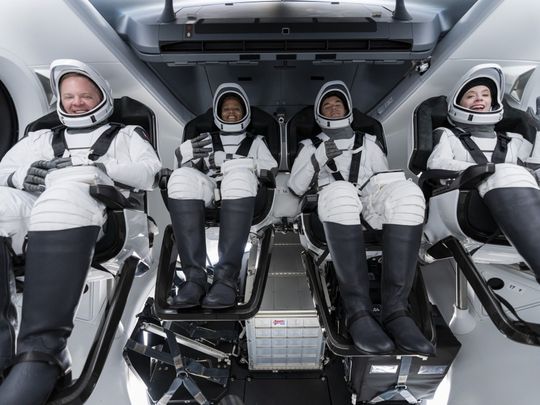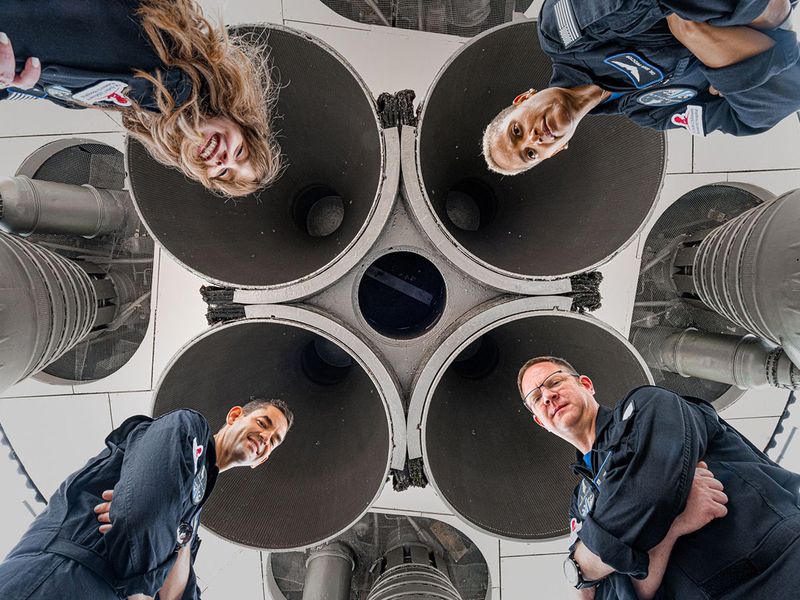
KENNEDY SPACE CENTER, United States: Can four people who’ve never been to space before spend three days spinning around Earth after only a few months of training?
That’s the challenge SpaceX has set for itself when it launches its first tourism mission on Wednesday, the first time a crew of exclusively private citizens will orbit our planet.
A five-hour launch window for “Inspiration4” opens from 8:02pm (0002 GMT Thursday).
A Falcon 9 rocket, with a Dragon capsule at its top, will blast off from the legendary launch complex 39A at NASA’s Kennedy Center in Florida, from where the Apollo 11 mission took off for the Moon.
The spaceship’s trajectory will take it to an altitude of 575 kilometers (357 miles), deeper into space than the International Space Station (ISS).
At the end of their journey, the four Americans will splash down off the coast of Florida, their descent slowed down by huge parachutes.
The mission was paid for by Jared Isaacman, a 38-year-old high school dropout and founder of Shift4 Payments.
SpaceX hasn’t disclosed what it cost him, but the price tag runs into tens of millions of dollars.

Here are the key facts about Inspiration4.
* The spacecraft: At the top of the Falcon 9 rocket, which is 70 meters high, sits the Dragon capsule, where the crew will be.
This spacecraft has already taken 10 astronauts to the International Space Station (ISS) on three separate missions.
The Dragon capsule, eight meters high and four meters wide, has been modified for this flight. A huge glass dome has been installed to offer passengers a 360-degree view of space.
* The flight schedule: Take-off is scheduled on Wednesday beginning at 8:02 pm (0002 GMT Thursday) from the NASA Kennedy Space Center in Florida. The launch window is five hours.
The first stage will separate from the spacecraft at an altitude of about 80 kilometers and will automatically return to Earth for future use.
During manned flights, the second stage usually separates about ten minutes after take-off.
The Dragon capsule will orbit Earth for three days at an altitude higher than the ISS.
After that, it will descend back to Earth, landing off the coast of Florida with the help of giant parachutes.
* The crew: Heading and financing the mission is US billionaire Jared Isaacman, who invited three other people to join him through an original selection process.
Hayley Arceneaux, 29, is a nurse and a pediatric cancer survivor.
Chris Sembroski, 42, is a US Air Force veteran who now works in the aviation industry.
Geology professor Sian Proctor, 51, was a finalist to become a NASA astronaut more than a decade ago.
* The training: The crew trained for just under six months, compared to years of preparation required for professional astronauts.
They learned to withstand the g-force by going on a spin in a centrifuge, and they experienced weightlessness.
Finally, although the flight should normally be fully automated, the team has been trained by SpaceX to take control in the event of an emergency.
* The research: The crew members’ sleep, heart rate, blood and cognitive functions will be analyzed during the mission in order to study how rookies react in space.
“We understand how lucky and fortunate we are,” Isaacman told a press briefing Tuesday.
For the trip, Isaacman is bringing along three others selected through a competition.
Hayley Arceneaux, a pediatric cancer survivor, is a 29-year-old physician assistant. She will be the youngest American to go into orbit and the first person with a prosthesis, on a part of her femur.
Chris Sembroski, 42, is a former US Air Force employee who now works in the aviation industry.
Sian Proctor, a 51-year-old geology professor, was almost selected to become an astronaut for NASA in 2009.
She will be only the fourth African American woman to go to space.
Physical training
The stated goal: to represent a turning point in the democratization of space, by proving that the cosmos is accessible to people who have not been handpicked and trained for many years as astronauts.
For SpaceX, this is nothing less than a first step towards a multi-planetary humanity - Elon Musk’s ultimate vision.
On board, their biological data (including their heart rate, sleep), as well as their cognitive capacities, will be analyzed.
They will also undergo tests before and after the trip, to measure its effect on their bodies. Their training only lasted about six months.
The flight should remain fully automated, but the crew has been trained by SpaceX to be able to take control in the event of an emergency.
They were also put through their paces physically.
Together, they trekked through the snow to summit Mount Rainier, which stands 14,411-foot-tall (3000 meters) in the country’s northwest.
They also completed high G force training on a centrifuge - a long spinning arm - and jet flights.
As well as serving as a vehicle for SpaceX’s ambitions, the mission aims to raise $200 million for St Jude’s Children’s Research Hospital, a leading facility in Memphis.
Arceneaux was treated there as a child, and now works there.
The crew will take with them various objects - a ukulele, 30 kilograms of hops intended to brew space beer, several non-fungible tokens - that will be auctioned off for this cause.
Space tourism
The space adventure caps a summer marked by the battle of the billionaires Richard Branson and Jeff Bezos to reach the final frontier.
The Virgin Galactic founder achieved the feat first, on July 11, and was followed by the Blue Origin boss nine days later.
But these flights only offered a few minutes of weightlessness. SpaceX’s mission is far more ambitious.
This will be the fourth crewed mission for SpaceX, having now sent 10 astronauts to the ISS.
The company is already working on future tourism missions, including one in January 2022 to the ISS.








